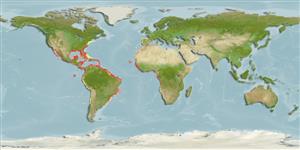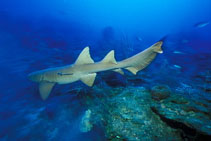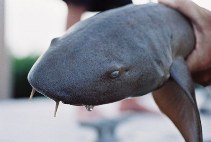Ginglymostoma cirratum (Bonnaterre, 1788)
Nurse shark
個人による観察記録の追加 Fish Watcher
| Native range | All suitable habitat | Point map | Year 2050 |

|
| This map was computer-generated and has not yet been reviewed. |
| Ginglymostoma cirratum AquaMaps Data sources: GBIF OBIS |
Dominican Republic country information
Common names:
Gata
Occurrence: native
Salinity: brackish
Abundance: | Ref:
Importance: | Ref:
Aquaculture: | Ref:
Regulations: | Ref:
Uses: no uses
Comments:
National Checklist:
Country Information: https://www.cia.gov/library/publications/resources/the-world-factbook/geos/dr.html
National Fisheries Authority: ttp://www.cep.unep.org/rep_dom/Rep_Dom.htm#SEA-PESQUERO
Occurrences: Occurrences Point map
Main Ref: Compagno, L.J.V., 1984
National Database:
Occurrence: native
Salinity: brackish
Abundance: | Ref:
Importance: | Ref:
Aquaculture: | Ref:
Regulations: | Ref:
Uses: no uses
Comments:
National Checklist:
Country Information: https://www.cia.gov/library/publications/resources/the-world-factbook/geos/dr.html
National Fisheries Authority: ttp://www.cep.unep.org/rep_dom/Rep_Dom.htm#SEA-PESQUERO
Occurrences: Occurrences Point map
Main Ref: Compagno, L.J.V., 1984
National Database:
Common names from other countries
分類 / Names 共通名の | 類義語 | Catalog of Fishes(部類, 種) | ITIS | CoL | WoRMS | Cloffa
板鰓亜鋼(サメとエイ類) (sharks and rays) > Orectolobiformes (Carpet sharks) > Ginglymostomatidae (Nurse sharks)
Etymology: Ginglymostoma: ginglymus (Gr.), hinge; stoma (Gr.), mouth, presumably referring to how corner of mouth has a hinged appearance (See ETYFish); cirratum: Latin for having tendrils, referring to elongated nasal barbels (See ETYFish).
More on author: Bonnaterre.
Etymology: Ginglymostoma: ginglymus (Gr.), hinge; stoma (Gr.), mouth, presumably referring to how corner of mouth has a hinged appearance (See ETYFish); cirratum: Latin for having tendrils, referring to elongated nasal barbels (See ETYFish).
More on author: Bonnaterre.
Environment: milieu / climate zone / depth range / distribution range 生態学
海; 汽水性の 関連する礁; 深さの範囲 0 - 130 m (Ref. 43278), usually 1 - 35 m (Ref. 40849). Subtropical; 44°N - 35°S, 122°W - 10°E (Ref. 43278)
分布 国々 | 国連食糧農業機関の区域 | エコシステム | 事件 | Point map | 導入 | Faunafri
Western Central Atlantic: Rhode Island to southern Brazil (south to Rio de Janeiro), including Gulf of Mexico and Caribbean coasts, although (exceptionally from Rhode Island to Texas), Bermuda; Eastern Central Atlantic: Cape Verde Islands, Senegal, Cameroon to Gabon, and rarely north to Bay of Biscaye, France (ref. 43278). Populations in eastern Pacific refer to Ginglymostoma unami Del Moral-Flores et al., 2015 (Ref. 113902).
Length at first maturity / サイズ / 重さ / 年齢
Maturity: Lm 235.0, range 230 - 240 cm
Max length : 430 cm TL オス/雌雄の選別がない; (Ref. 96339); common length : 304 cm TL オス/雌雄の選別がない; (Ref. 247); 最大公表体重: 109.6 kg (Ref. 40637); 最大記録サイズ: 25 年 (Ref. 72467)
Max length : 430 cm TL オス/雌雄の選別がない; (Ref. 96339); common length : 304 cm TL オス/雌雄の選別がない; (Ref. 247); 最大公表体重: 109.6 kg (Ref. 40637); 最大記録サイズ: 25 年 (Ref. 72467)
簡単な記述 検索表 | 形態学 | 形態計測学
背面の脊椎 (合計) : 0. Moderately long barbels, nasoral grooves present but no perinasal grooves, mouth well in front of eyes, spiracles minute, precaudal tail shorter than head and body, dorsal fins broadly rounded (the first much larger than the second and anal fins), caudal fin moderately long, over 1/4 of total length, yellow-brown to grey-brown in color, with or without small dark spots and obscure dorsal saddle markings (Ref. 247). Head blunt, mouth inferior, pair of conspicuous barbels between nostrils (Ref. 26938).
Found on continental and insular shelves. Solitary (Ref. 26340) and sluggish fish, often encountered lying on the bottom (Ref. 9987). Nocturnal, feeding on bottom invertebrates such as spiny lobsters, shrimps, crabs, sea urchins, squids, octopi, snails and bivalves, and fishes like catfishes, mullets, puffers and stingrays. Ovoviviparous with 21 to 28 young in a litter (Ref. 9987, 43278). Kept in captivity for researches. May attack humans if they are molested or stepped upon accidentally. Edible, but mainly valued for its hide, which makes extremely tough and durable leather (Ref. 9987). Common over shallow sand flats, in channels, and around coral reefs; young may be found among prop roots of red mangroves (Ref. 26938).
Life cycle and mating behavior 成熟 | 繁殖 | 放精 | 卵 | 生産力 | 幼生
Ovoviviparous, with 21 to 28 young in a litter. Development of young in the uterus being sustained by a large supply of yolk. Females give birth in late spring and summer in waters off Florida. During courtship, a pair sometimes a triplet of adults engaged in synchronized parallel swimming. While on it, the male may grab one of the female's pectoral fins with his mouth which induces the female to pivot 90° and roll on her back on the bottom. Then the male inserts a clasper in her vent, and then roll on his back beside the female. Pair may break apart and depart rapidly after copulation or the male may remain motionless on the subtrate as if recovering from the mating bout (Ref. 49562). Not all attempts of males to copulate with a female nurse shark result in successful fertilization, females may employ avoidance by 'pivotting and rolling' to escape from male attention (Ref. 49562). Or females may 'lie on back' and rest motionless and rigidly on the substrate (Ref. 51113, 49562). On the contrary, females send signals of readiness to copulate with males by arching their body toward their male partner and cupping the pelvic fin (Ref. 51126, 49562). Male nurse sharks may mate with many females over several weeks (polygyny) and vice versa (polyandry) (Ref. 49562). Also Ref. 205.
主な参考文献
Upload your references | 参考文献 | コーディネーター : Compagno, Leonard J.V. | 協力者
Compagno, L.J.V., 1984. FAO Species Catalogue. Vol. 4. Sharks of the world. An annotated and illustrated catalogue of shark species known to date. Part 1 - Hexanchiformes to Lamniformes. FAO Fish. Synop. 125(4/1):1-249. Rome, FAO. (Ref. 247)
Human uses
水産業: 少数商業の; ゲームフィッシュ: はい; 水族館・水槽: 公共の水族館
FAO(水産業: 代謝, 種の外形; publication : search) | FishSource | 私達の周りの海
より多くの情報
Population dynamics
成長のパラメーター
Max. ages / sizes
Length-weight rel.
Length-length rel.
体長組成
Mass conversion
補充
豊度
成長のパラメーター
Max. ages / sizes
Length-weight rel.
Length-length rel.
体長組成
Mass conversion
補充
豊度
Physiology
Body composition
Nutrients
酸素消費
水泳形態
泳ぐ速さ
Visual pigments
Fish sound
Diseases & Parasites
Toxicity (LC50s)
Body composition
Nutrients
酸素消費
水泳形態
泳ぐ速さ
Visual pigments
Fish sound
Diseases & Parasites
Toxicity (LC50s)
用具
Bio-Quiz | E-book | 野外観察図鑑 | Length-frequency wizard | 生活史の基盤ツール | 目的のマップ | Classification Tree
| Catch-MSY |
特記事項
XMLをダウンロードして下さい
インターネットの情報源
Aquatic Commons | BHL | Cloffa | Websites from users | Check FishWatcher | CISTI | Catalog of Fishes(部類, 種) | DiscoverLife | DORIS | ECOTOX | Faunafri | Fishtrace | GenBank(ゲノム, ヌクレオチド) | GloBI | GOBASE | GoMexSI (interaction data) | | Google Books | Google Scholar | Google | IGFA World Record | MitoFish | 国のデーターベース | Otolith Atlas of Taiwan Fishes | 公共の水族館 | PubMed | Reef Life Survey | Scirus | SeaLifeBase | 生命の木 | Wikipedia(行く, 検索する) | World Records Freshwater Fishing | 動物に関する記録
Estimates based on models
Preferred temperature (Ref. 115969): 22.3 - 28, mean 25.5 (based on 798 cells).
Phylogenetic diversity index (Ref. 82804): PD50 = 0.8125 [Uniqueness, from 0.5 = low to 2.0 = high].
Bayesian length-weight: a=0.00417 (0.00157 - 0.01105), b=3.08 (2.85 - 3.31), in cm Total Length, based on LWR estimates for this (Sub)family-body shape (Ref. 93245).
栄養段階 (Ref. 69278): 4.2 ±0.2 se; based on diet studies.
回復力 (Ref. 120179): 低い, 4.5年~14年の倍増期間の最小個体群 (K=0.14; tmax=25; Fec=21-28).
Fishing Vulnerability (Ref. 59153): Very high vulnerability (90 of 100).
Climate Vulnerability (Ref. 125649): High vulnerability (65 of 100).





